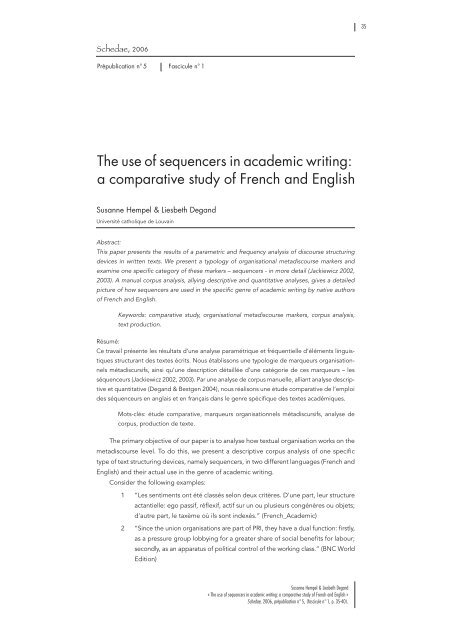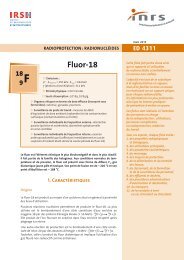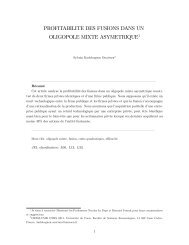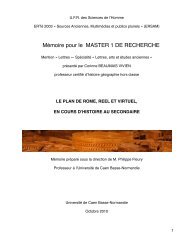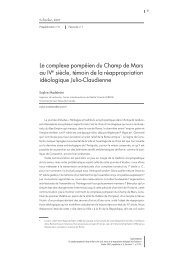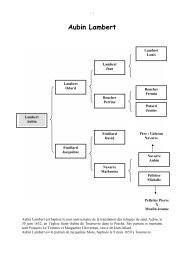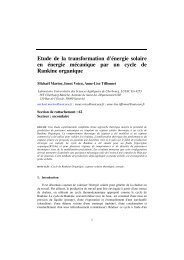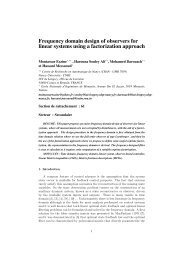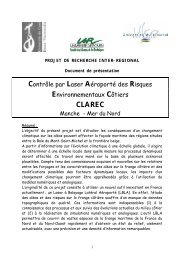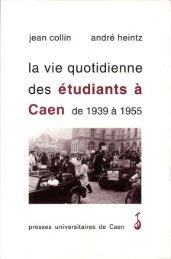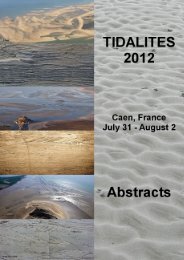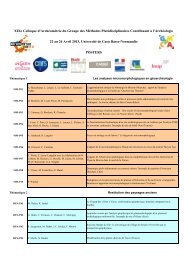The use of sequencers in academic writing - Université de Caen ...
The use of sequencers in academic writing - Université de Caen ...
The use of sequencers in academic writing - Université de Caen ...
Create successful ePaper yourself
Turn your PDF publications into a flip-book with our unique Google optimized e-Paper software.
35<br />
Schedae, 2006<br />
Prépublication n° 5 Fascicule n° 1<br />
<strong>The</strong> <strong>use</strong> <strong>of</strong> <strong>sequencers</strong> <strong>in</strong> <strong>aca<strong>de</strong>mic</strong> writ<strong>in</strong>g:<br />
a comparative study <strong>of</strong> French and English<br />
Susanne Hempel & Liesbeth Degand<br />
Université catholique <strong>de</strong> Louva<strong>in</strong><br />
Abstract:<br />
This paper presents the results <strong>of</strong> a parametric and frequency analysis <strong>of</strong> discourse structur<strong>in</strong>g<br />
<strong>de</strong>vices <strong>in</strong> written texts. We present a typology <strong>of</strong> organisational metadiscourse markers and<br />
exam<strong>in</strong>e one specific category <strong>of</strong> these markers – <strong>sequencers</strong> - <strong>in</strong> more <strong>de</strong>tail (Jackiewicz 2002,<br />
2003). A manual corpus analysis, ally<strong>in</strong>g <strong>de</strong>scriptive and quantitative analyses, gives a <strong>de</strong>tailed<br />
picture <strong>of</strong> how <strong>sequencers</strong> are <strong>use</strong>d <strong>in</strong> the specific genre <strong>of</strong> <strong>aca<strong>de</strong>mic</strong> writ<strong>in</strong>g by native authors<br />
<strong>of</strong> French and English.<br />
Keywords: comparative study, organisational metadiscourse markers, corpus analysis,<br />
text production.<br />
Résumé:<br />
Ce travail présente les résultats d’une analyse paramétrique et fréquentielle d’éléments l<strong>in</strong>guistiques<br />
structurant <strong>de</strong>s textes écrits. Nous établissons une typologie <strong>de</strong> marqueurs organisationnels<br />
métadiscursifs, a<strong>in</strong>si qu’une <strong>de</strong>scription détaillée d’une catégorie <strong>de</strong> ces marqueurs – les<br />
séquenceurs (Jackiewicz 2002, 2003). Par une analyse <strong>de</strong> corpus manuelle, alliant analyse <strong>de</strong>scriptive<br />
et quantitative (Degand & Bestgen 2004), nous réalisons une étu<strong>de</strong> comparative <strong>de</strong> l’emploi<br />
<strong>de</strong>s séquenceurs en anglais et en français dans le genre spécifique <strong>de</strong>s textes académiques.<br />
Mots-clés: étu<strong>de</strong> comparative, marqueurs organisationnels métadiscursifs, analyse <strong>de</strong><br />
corpus, production <strong>de</strong> texte.<br />
<strong>The</strong> primary objective <strong>of</strong> our paper is to analyse how textual organisation works on the<br />
metadiscourse level. To do this, we present a <strong>de</strong>scriptive corpus analysis <strong>of</strong> one specific<br />
type <strong>of</strong> text structur<strong>in</strong>g <strong>de</strong>vices, namely <strong>sequencers</strong>, <strong>in</strong> two different languages (French and<br />
English) and their actual <strong>use</strong> <strong>in</strong> the genre <strong>of</strong> <strong>aca<strong>de</strong>mic</strong> writ<strong>in</strong>g.<br />
Consi<strong>de</strong>r the follow<strong>in</strong>g examples:<br />
1 “Les sentiments ont été classés selon <strong>de</strong>ux critères. D'une part, leur structure<br />
actantielle: ego passif, réflexif, actif sur un ou plusieurs congénères ou objets;<br />
d'autre part, le taxème où ils sont <strong>in</strong><strong>de</strong>xés.” (French_Aca<strong>de</strong>mic)<br />
2 “S<strong>in</strong>ce the union organisations are part <strong>of</strong> PRI, they have a dual function: firstly,<br />
as a pressure group lobby<strong>in</strong>g for a greater share <strong>of</strong> social benefits for labour;<br />
secondly, as an apparatus <strong>of</strong> political control <strong>of</strong> the work<strong>in</strong>g class.” (BNC World<br />
Edition)<br />
Susanne Hempel & Liesbeth Degand<br />
« <strong>The</strong> <strong>use</strong> <strong>of</strong> <strong>sequencers</strong> <strong>in</strong> <strong>aca<strong>de</strong>mic</strong> writ<strong>in</strong>g: a comparative study <strong>of</strong> French and English »<br />
Schedae, 2006, prépublication n°5, (fascicule n°1, p. 35-40).
36<br />
In both examples, the i<strong>de</strong>ational content <strong>of</strong> the text is structured by l<strong>in</strong>guistic items (d’une<br />
part/ d’autre part; firstly/ secondly). <strong>The</strong>se sequenc<strong>in</strong>g <strong>de</strong>vices are items belong<strong>in</strong>g to the<br />
doma<strong>in</strong> <strong>of</strong> textual metadiscourse, whose function is to allow the un<strong>de</strong>rstand<strong>in</strong>g <strong>of</strong> the primary<br />
message by mak<strong>in</strong>g explicit the organisational structure <strong>of</strong> the propositional content (Hyland<br />
1998). Build<strong>in</strong>g our conception <strong>of</strong> metadiscourse on Hyland’s typology 1 , we focus on his<br />
category <strong>of</strong> frame markers as they best represent what we call organisational metadiscourse<br />
markers. A further categorisation <strong>of</strong> these markers has been <strong>de</strong>veloped: Our new subdivision<br />
consists <strong>of</strong> <strong>sequencers</strong> (elements <strong>use</strong>d to <strong>in</strong>troduce a sequence <strong>in</strong> the discourse), topicalisers<br />
(elements <strong>in</strong>dicat<strong>in</strong>g the <strong>in</strong>troduction <strong>of</strong> a new subject), illocution markers (elements<br />
<strong>in</strong>dicat<strong>in</strong>g the illocutionary act the writer has been realis<strong>in</strong>g <strong>in</strong> the discourse) and reviews/<br />
previews (elements anticipat<strong>in</strong>g or repeat<strong>in</strong>g a stage <strong>in</strong> the discourse).<br />
Our un<strong>de</strong>rstand<strong>in</strong>g <strong>of</strong> <strong>sequencers</strong> is based on the theoretical framework <strong>of</strong> discourse and<br />
cognition proposed by Charolles (1997) and on the methodological outl<strong>in</strong>e <strong>of</strong> MIL (marqueurs<br />
d’<strong>in</strong>tégration l<strong>in</strong>éaires) <strong>de</strong>scribed by Jackiewicz (2002). Follow<strong>in</strong>g these authors’ approach,<br />
<strong>sequencers</strong> can be classified <strong>in</strong>to three types: spatial <strong>sequencers</strong> (l<strong>in</strong>guistic elements relative<br />
to space), temporal <strong>sequencers</strong> (<strong>in</strong>troduc<strong>in</strong>g a temporal sequence) and numerical <strong>sequencers</strong><br />
(elements relative to enumeration).<br />
<strong>The</strong> series <strong>of</strong> a sequence follow certa<strong>in</strong> structural parameters. We <strong>de</strong>f<strong>in</strong>ed a reference<br />
structure <strong>of</strong> a sequence, draw<strong>in</strong>g both on the analysis <strong>of</strong> some <strong>in</strong>stances <strong>of</strong> these structures and<br />
on the study <strong>of</strong> different theoretical mo<strong>de</strong>ls, notably the one by Jackiewicz & M<strong>in</strong>el (2003).<br />
– A typical sequence has to be <strong>in</strong>troduced by an <strong>in</strong>troductory phrase, clearly stat<strong>in</strong>g the<br />
ma<strong>in</strong> fe<strong>de</strong>rative i<strong>de</strong>a with the help <strong>of</strong> a quantifier and a classifier. <strong>The</strong> <strong>in</strong>troductory phrase<br />
can be a separate phrase before the organisational frame, it can be a proposition at the<br />
head <strong>of</strong> the same phrase conta<strong>in</strong><strong>in</strong>g the sequencer, or it can be situated after the several<br />
series <strong>of</strong> the sequence;<br />
– Each series constitutes an organisational frame, and each organisational frame has to<br />
be opened explicitly by a sequencer, or implicitly by another l<strong>in</strong>guistic item which signposts<br />
the beg<strong>in</strong>n<strong>in</strong>g <strong>of</strong> its series;<br />
– <strong>The</strong> <strong>sequencers</strong> are organised as follows: the first sequencer is the ‘<strong>in</strong>dicator’, followed<br />
by the ‘<strong>in</strong>termediate’ sequencer and the ‘clos<strong>in</strong>g sequencer’. If there are only two <strong>sequencers</strong><br />
<strong>in</strong> a sequence, the last sequencer automatically makes up the ‘clos<strong>in</strong>g sequencer’;<br />
– A sequence should preferentially be homogeneous; it is not homogeneous if it conta<strong>in</strong>s<br />
constituents belong<strong>in</strong>g to two different series, if the sequence is <strong>in</strong>complete or not explicitly<br />
closed, or if the sequence presents a certa<strong>in</strong> variability concern<strong>in</strong>g the classifier;<br />
– A m<strong>in</strong>imal sequence should be two-fold, but there is no restriction as to a maximum <strong>of</strong><br />
series <strong>in</strong> a sequence;<br />
– <strong>The</strong> <strong>sequencers</strong> are <strong>in</strong><strong>de</strong>pen<strong>de</strong>nt <strong>of</strong> the propositional content <strong>of</strong> the phrase, and as such<br />
are supposed to be mostly placed at the beg<strong>in</strong>n<strong>in</strong>g <strong>of</strong> the sentence, either without or<br />
before a punctuation marker;<br />
– <strong>The</strong> scope <strong>of</strong> the <strong>in</strong>dividual <strong>sequencers</strong> can be on an <strong>in</strong>tra-sentential level, or on an <strong>in</strong>tersentential<br />
level;<br />
– Another sequence can be embed<strong>de</strong>d <strong>in</strong> the ma<strong>in</strong> sequence, and if this is the case, the<br />
same structural parameters apply to it.<br />
I<strong>de</strong>ally, follow<strong>in</strong>g these parameters, a sequence should look like this:<br />
1. Hyland’s taxonomy <strong>of</strong> textual metadiscourse is five-fold, conta<strong>in</strong><strong>in</strong>g transitions, frame markers, endophoric<br />
markers and co<strong>de</strong> glosses (Hyland 1998).<br />
Schedae, 2006, prépublication n°5, (fascicule n°1, p. 35-40).
37<br />
3 He gives three ma<strong>in</strong> reasons for his doubts –<br />
• Firstly, he could not reconcile his own experience with the <strong>de</strong>scriptions<br />
<strong>of</strong> conversion given <strong>in</strong> books on the subject, such as Repentance by<br />
William Perk<strong>in</strong>s;<br />
• Secondly, he was disturbed by the fact that spiritual truths didn’t stir his<br />
emotions or grip his imag<strong>in</strong>ation as Perk<strong>in</strong>s;<br />
• Thirdly, he was concerned about the possibility that his faith was merely<br />
an <strong>in</strong>tellectual un<strong>de</strong>rstand<strong>in</strong>g coupled with a fear <strong>of</strong> God, and that he<br />
was not truly regenerate. (BNC World Edition).<br />
In a preced<strong>in</strong>g corpus analysis <strong>of</strong> English (Hempel & Degand 2005), the actual <strong>use</strong> <strong>of</strong><br />
<strong>sequencers</strong> has been analysed with respect to this reference mo<strong>de</strong>l. We <strong>de</strong>rived a <strong>de</strong>tailed<br />
picture <strong>of</strong> how native authors <strong>use</strong> <strong>sequencers</strong> <strong>in</strong> their texts, and how they are distributed<br />
among different text genres. <strong>The</strong> results showed that the actual <strong>use</strong> <strong>of</strong> <strong>sequencers</strong> does not<br />
correspond to the prescription <strong>of</strong> manuals for L1 writers. While such gui<strong>de</strong>s urge them to <strong>use</strong><br />
structur<strong>in</strong>g <strong>de</strong>vices <strong>in</strong> or<strong>de</strong>r to be more coherent and recommend homogeneous/ complete<br />
series <strong>of</strong> metadiscourse markers, concrete texts do not apply those rules. Furthermore, writers<br />
are obviously not precise when us<strong>in</strong>g specific series <strong>of</strong> <strong>sequencers</strong> and complete sequences.<br />
Moreover, genre proved to be a <strong>de</strong>cisive factor concern<strong>in</strong>g the choice <strong>of</strong> structur<strong>in</strong>g <strong>de</strong>vices.<br />
Our hypothesis that <strong>aca<strong>de</strong>mic</strong> writ<strong>in</strong>g is the genre the most structured by metadiscourse<br />
markers proved to be right. We are therefore <strong>in</strong>terested <strong>in</strong> a comparative study <strong>of</strong> how<br />
<strong>sequencers</strong> are <strong>use</strong>d <strong>in</strong> this specific genre, both <strong>in</strong> English and French.<br />
<strong>The</strong> methodology we <strong>use</strong>d to conduct our study consists <strong>in</strong> a parametric and statistical<br />
analysis <strong>of</strong> the given corpus data (Degand & Bestgen 2004, Pit 2003, Pan<strong>de</strong>r Maat & Degand<br />
2001, Spooren, San<strong>de</strong>rs, Huiskes, Degand, <strong>in</strong> press). It allows us to comb<strong>in</strong>e a quantitative<br />
approach – or more precisely, a frequency analysis – with a qualitative one – that is to say,<br />
a parametric analysis <strong>of</strong> our data. This method is situated on a cont<strong>in</strong>uum where “<strong>in</strong>tuition<br />
and data collection work hand <strong>in</strong> hand” (Part<strong>in</strong>gton 1998: 1): between a strictly <strong>de</strong>ductive<br />
approach, exclusively rely<strong>in</strong>g on the researcher’s <strong>in</strong>tuition as a native speaker, and a strictly<br />
<strong>in</strong>ductive approach, exclusively foun<strong>de</strong>d on the l<strong>in</strong>guistic facts. <strong>The</strong> corpus we <strong>use</strong>d for the<br />
present study <strong>in</strong> English is a sub-corpus <strong>of</strong> <strong>aca<strong>de</strong>mic</strong> writ<strong>in</strong>g <strong>of</strong> 28 421 624 words, retrieved<br />
from the BNC. <strong>The</strong> French corpus (1 380 956 words) is an assembly <strong>of</strong> freely available onl<strong>in</strong>e<br />
papers, stemm<strong>in</strong>g from three sources: the publications from IFRI, and from the onl<strong>in</strong>e journals<br />
Methodos and Texto 2 .<br />
<strong>The</strong> results <strong>of</strong> our frequency analysis show how the chosen <strong>sequencers</strong> are distributed<br />
among the two languages. As our corpora were not <strong>of</strong> equal size, it was necessary to apply<br />
a coefficient to harmonise results over one million words (Table 1).<br />
FRENCH 1 380 956 ENGLISH 28 421 624<br />
occurrences /1 000 000 /1 000 000 occurrences<br />
D’une part 146 105,72 15,66 445 On the one hand<br />
D’autre part 133 96,31 52,04 1479 On the other hand<br />
Premièrement 29 21,00 18,19 517 Firstly<br />
Deuxièmement 28 20,28 31,49 895 Secondly<br />
Troisièmement 7 5,07 9,53 271 Thirdly<br />
D’abord 243 175,97 11,65 331 At first<br />
Ensuite 210 152,07 143,83 4088 <strong>The</strong>n<br />
Enf<strong>in</strong> 523 378,72 62,87 1787 F<strong>in</strong>ally<br />
Table 1: Frequency Analysis.<br />
2. We would like to thank Lydia-Mai Ho-Dac (University <strong>of</strong> Toulo<strong>use</strong>) and Paula Chesley (University at Buffalo)<br />
for mak<strong>in</strong>g these data available to us.<br />
Schedae, 2006, prépublication n°5, (fascicule n°1, p. 35-40).
38<br />
As we can see, there is a difference <strong>in</strong> French and <strong>in</strong> English concern<strong>in</strong>g the homogeneous<br />
<strong>use</strong> <strong>of</strong> <strong>sequencers</strong>. In French, the spatial sequence d’une part/ d’autre part is <strong>use</strong>d<br />
<strong>in</strong> a homogeneous way, the <strong>in</strong>dicator d’une part co-occur<strong>in</strong>g quasi systematically with the<br />
clos<strong>in</strong>g sequence d’autre part, whereas <strong>in</strong> English, the un<strong>de</strong>r-<strong>use</strong> <strong>of</strong> the <strong>in</strong>dicator (on the<br />
one hand) is apparent. <strong>The</strong> same difference has been noticed with the numerical sequence,<br />
whose chronological or<strong>de</strong>r is respected <strong>in</strong> French, but not <strong>in</strong> English. And as to the temporal<br />
sequence, English aga<strong>in</strong> shows an un<strong>de</strong>r-<strong>use</strong> <strong>of</strong> the <strong>in</strong>dicator when compared to French.<br />
It can be said that <strong>in</strong> French, the sequences seem to be more homogeneous or complete<br />
than <strong>in</strong> English, when consi<strong>de</strong>r<strong>in</strong>g the amount <strong>of</strong> <strong>in</strong>dicators and <strong>in</strong>termediate <strong>sequencers</strong>.<br />
Our parametric study yiel<strong>de</strong>d <strong>in</strong>terest<strong>in</strong>g results as well (Table 2). It can be observed<br />
that the <strong>use</strong> <strong>of</strong> the three sequencer types is pr<strong>in</strong>cipally similar <strong>in</strong> both languages. M<strong>in</strong>or differences<br />
concern the <strong>in</strong>troduction <strong>of</strong> a sequence by a preced<strong>in</strong>g phrase, sentential scope,<br />
completeness and the number <strong>of</strong> series <strong>in</strong> a sequence. However, a major difference has<br />
been noticed concern<strong>in</strong>g syntax: it appears that English authors make <strong>use</strong> <strong>of</strong> a bigger variety<br />
<strong>of</strong> syntactic position <strong>in</strong> their texts. As to spatial <strong>sequencers</strong>, they also show a bigger variety<br />
<strong>of</strong> the position <strong>of</strong> punctuation markers than <strong>in</strong> French. This un<strong>de</strong>r-<strong>use</strong> <strong>of</strong> syntactic possibilities<br />
<strong>in</strong> French seems odd, especially if one consi<strong>de</strong>rs the relative liberty <strong>in</strong> French syntax. As it<br />
seems easier to juggle with the syntactic position <strong>of</strong> metadiscourse markers <strong>in</strong> French, a concrete<br />
study <strong>in</strong> text production has to be un<strong>de</strong>rtaken. This result confirms the observation <strong>in</strong><br />
our frequency analysis, namely that French authors apply the parameters <strong>of</strong> our reference<br />
mo<strong>de</strong>l more rigorously than English authors, and tend to produce more complete sequences.<br />
Sequencer<br />
type<br />
Spatial<br />
sequencer<br />
Numerical<br />
sequencer<br />
Temporal<br />
sequencer<br />
Parameters ENGLISH FRENCH<br />
Common<br />
Introductory phrase<br />
Nb. <strong>of</strong> series <strong>in</strong> sequence<br />
Homogeneity/ completeness<br />
Syntactic position<br />
Punctuation<br />
Scope<br />
Classifier<br />
Quantifier<br />
Introductory phrase<br />
Nb. <strong>of</strong> series <strong>in</strong> sequence<br />
Homogeneity/ completeness<br />
Syntactic position<br />
Punctuation<br />
Scope<br />
Classifier<br />
Quantifier<br />
Introductory phrase<br />
Nb. <strong>of</strong> series <strong>in</strong> sequence<br />
Homogeneity/ completeness<br />
Syntactic position<br />
Punctuation<br />
Scope<br />
Classifier<br />
Quantifier<br />
yes<br />
no<br />
2 series<br />
yes<br />
<strong>in</strong>itial/ middle<br />
middle<br />
absent/ after/ enclos<strong>in</strong>g<br />
after<br />
<strong>in</strong>tra-sentential<br />
yes<br />
no<br />
no<br />
yes<br />
3 series 2 series / +3 series<br />
yes/no<br />
yes<br />
<strong>in</strong>itial<br />
after<br />
<strong>in</strong>ter-sentential<br />
yes<br />
specified<br />
no<br />
2 series 1 /2 /3 series<br />
no<br />
<strong>in</strong>itial/ middle<br />
middle<br />
absent<br />
<strong>in</strong>tra-sentential<br />
<strong>in</strong>ter-sentential<br />
no<br />
no<br />
Table 2. Parametric Analysis.<br />
<strong>The</strong> results <strong>of</strong> this study, i.e. the differences and common po<strong>in</strong>ts between French and<br />
English as to the <strong>use</strong> <strong>of</strong> metadiscursive items, will serve as an <strong>in</strong>terest<strong>in</strong>g basel<strong>in</strong>e for future<br />
research <strong>in</strong> L2. We would like to exam<strong>in</strong>e how language learners <strong>of</strong> both languages handle<br />
these differences when transferr<strong>in</strong>g from their mother tongue to L2. How are the differences<br />
transferred, and how are the common characteristics transferred? How does metadiscourse<br />
<strong>in</strong>fluence L2 production? <strong>The</strong>se questions will need further analysis.<br />
Schedae, 2006, prépublication n°5, (fascicule n°1, p. 35-40).
39<br />
Bibliography<br />
CHAROLLES M. (1997), “L’encadrement du discours – Univers, champ, doma<strong>in</strong>es et espace”, Cahier <strong>de</strong><br />
recherche l<strong>in</strong>guistique, 6.<br />
DEGAND L. & BESTGEN Y. (2004), “Connecteurs et analyse <strong>de</strong> corpus: <strong>de</strong> l’analyse manuelle à l’analyse<br />
automatisée”, <strong>in</strong> L’Unité Texte, S. Porhiel and D. Kl<strong>in</strong>gler (eds), France, Perspective, p. 49-73.<br />
HEMPEL S. & DEGAND L. (2005), “Qualitative analysis <strong>of</strong> <strong>sequencers</strong> <strong>in</strong> three text genres: <strong>aca<strong>de</strong>mic</strong> writ<strong>in</strong>g,<br />
journalese and fiction” (submitted).<br />
HYLAND K. (1998), “Persuasion and Context: <strong>The</strong> pragmatics <strong>of</strong> <strong>aca<strong>de</strong>mic</strong> discourse”, Journal <strong>of</strong> Pragmatics,<br />
30, p. 437-455.<br />
HYLAND K. & TSE P. (2004), “Metadiscourse <strong>in</strong> Aca<strong>de</strong>mic Writ<strong>in</strong>g: A Reappraisal”, Applied L<strong>in</strong>guistics, 25, 2,<br />
p. 156-177.<br />
JACKIEWICZ A. (2002), “Repérage et délimitation <strong>de</strong>s cadres organisationnels pour la segmentation<br />
automatique <strong>de</strong>s textes”, <strong>in</strong> Actes <strong>de</strong> CIFT’02, Hammamet, Tunisia, p. 95-105.<br />
JACKIEWICZ A. & MINEL J. (2003), “L’i<strong>de</strong>ntification <strong>de</strong>s structures discursives engendrées par les cadres<br />
organisationnels”, <strong>in</strong> Actes <strong>de</strong> la 10 e Conférence Traitement Automatique du Langage Naturel (TALN 2003),<br />
Batz-sur-Mer, p. 155-164.<br />
PANDER MAAT H. & DEGAND L. (2001), “Scal<strong>in</strong>g causal relations and connectives <strong>in</strong> terms <strong>of</strong> Speaker<br />
Involvement”, Cognitive L<strong>in</strong>guistics, 12, p. 211-245.<br />
PIT M. (2003), How to express yourself with a causal connective – Subjectivity and causal connectives <strong>in</strong><br />
Dutch, German and French, Amsterdam – New York, Rodopi – USL&C.<br />
SPOOREN W., SANDERS T., HUISKES M. & DEGAND L. (to appear), “Subjectivity and Causality: A Corpus Study<br />
<strong>of</strong> Spoken Language”, <strong>in</strong> Empirical and Experimental Methods <strong>in</strong> Cognitive/Functional Research, S. Rice<br />
and J. Newman (eds), CSLI Publications.<br />
TURCO G. & COLTIER D. (1988), “Des agents doubles <strong>de</strong> l’organisation textuelle, les marqueurs d’<strong>in</strong>tégration<br />
l<strong>in</strong>éaire”, Pratiques, 57, p. 57-79.<br />
Schedae, 2006, prépublication n°5, (fascicule n°1, p. 35-40).
40<br />
Schedae, 2006, prépublication n°5, (fascicule n°1, p. 35-40).


